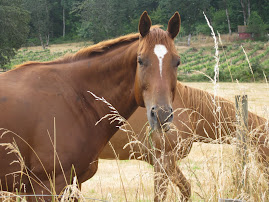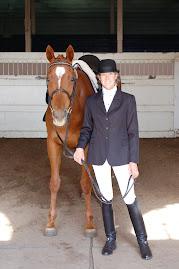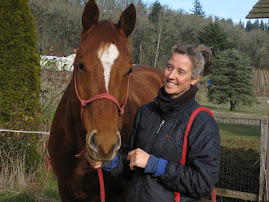When did it become acceptable to use the lunge line as way to let your horse be a moron because they have "get their energy out?" ??????
IT doesn't make sense to allow your horse do to WHATEVER it wants in circles around you, then expect him/her to BEHAVE when you handle or ride him/her. ?????????
The things I see people do with their horses on the lunge line is
One. Of. My. Pet. Peeves.
Does it show??
Any time you are with your horse, your are TRAINING your horse how to respond to you. Whether it is feeding time, blanket time, turn-out time...the list goes on, it is YOUR JOB to be the Alpha of the herd - no Ifs, Ands, or Butts! about it.
Yet, there is still this idea that the paces people put their horses through on the lunge line somehow do not apply.
IT IS ALL TRAINING.
With that in mind - Re-Think your expectations on the lunge line. It is YOUR time with your horse, Sooooooooooooooooo...turn that session on the lunge line towards YOUR benefit, and eventually the horse's.
When Trevor was towards the end of his official recovery time from colic surgey (three months), I did not want to hop on an expect him to be rideable. So, I lunged him. Since he was still in a muscle-building recovery mode, he did not have the options to be a moron on the lunge line. With weak belly muscles, no topline, no hindquarters, the last thing I wanted him to do was compromise his already delicate muscle structure. Granted - I used the lunge line from a "working" point-of-view before, I just re-defined the expectations.
My re-defined expectation was that the lunge line was a) the horse's job for that session b) RELAXATION.
Yes - I was able to teach my horse to RELAX while lunging.
You can, too!
Began your lunge session with the horse at a walk. Re-direct any behavior that isn't consistent with a walk (that! is usually pretty obvious...). Then, the horse's job is to walk until he/she chews. Now - this could take a while with an uptight horse still learning the art of relaxation, so give you and your horse that time. When you do get the "chew," change directions AT THE WALK! and do the same thing the other way. It may be that your first few sessions are at the walk only, but don't fret! The expectation of something, anything!, new to a horse takes sometime to learn.
When you get the chew in both directions, then do the SAME THING at the trot. Wait for the chew on the lunge line, ask for the walk, and then change direction.
A note for the TROT - to help your horse fine the relax and chew, ask him/her to SLOW the Trot down. A horse trotting a million miles an hour will have great difficulty finding a space to relax. Not only does slowing the trot down help your horse relax, it helps your horse find a RHYTHM. Rhythm is a key element in any successful horse and rider combination. Have the expectation of relax and rhythm.
When you get the chew in both directions, then do the SAME THING at the canter.
As the canter can be a difficult gait for the green and/or unbalanced horse, be a bit more forgiving (only in the gait, not in attitude!). I look for other signs of relaxation in the canter due to it's three beat nature. Trevor tends to "blow" when he is relaxing in the canter and then chew after the down transition to the trot. Help the horse to find the rhythm, give the horse trot breaks and get the chew in the trot before asking for the canter again.
Another kudo that happens when you lunge for the chew and relaxation is the
S T R E T C H Over the topline.
Some horses naturally do this, others need help. Encourage your horse ANYTIME he/she offers to lower his/her head. It can start small, but soon they learn that it is nice to stretch down and move those back muscles. It then becomes a good indicator of how relaxed horse is that day.
So! RE-THINK! the lunge line and create a new way to play with your horse.
Wednesday, February 15, 2012
Wednesday, February 8, 2012
Leg Mover?? Back Mover??
Read Dr. Gerd Heuschmann's book about Classic vs. "Modern" Dressage and you will read about Leg and Back Movers.
Watch horses that are compressed into a frame and you will see a Leg Mover...
Watch horses allowed to stretch through their frame and you will see a Back Mover...
The labels imply exactly what happens when a horse is ridden in a "compressed" frame as opposed to a "through" frame.
COMPRESSION is created when a horse is ridden from front-to-back and the major focal point of WHERE the horse is ridden from is the rider's reins.
In a compression frame, the horse is ridden with short reins, the legs and seat are used to drive the horse forward, and "into" the bridle. This is what has become to be understood as "Collection"....However, when the reins are shortened and the horse is driven, the opposite happens...
As the legs push the horse forward, the seat tends to be heavy and pushes down on the horse's back, causing tension over the topline, driving the horse's back away from the rider's seat in a concave arch.
The reins are then short and restrictive through the overuse of the halfhalt, creating lack of movement throughout the neck and poll, therefore allowing the horse to drop his/her shoulders (incorrect).
This style of riding creates a horse who is locked in his/her poll, stiff in his/her neck, dropped in his/her back, locked in his/her ribcage, and! not using his/her hindend correctly, therefore heavy on the frontend.
It would SEEM that this would work to ride a horse this way...but what this style of riding creates is a sore and grumpy horse who lacks muscle tone in all the right places. Tense Back. Tense Horse. Only the legs move...
It creates a LEG MOVER.
THROUGH is created when a horse is ridden from back-to-front and the
major focal point of WHERE the horse is ridden from is the rider's body.
In a through frame, the horse is ridden from the body where the legs and seat allow the horse to find the bridle, therefore, be ridden "into" the bridle. "Collection" can also be achieved in this frame, but it takes time as the horse is slowly brought into a state of collection...
As the legs push the horse forward, the seat is soft and allows a "place" for the back. When the seat needs to "drive," it is in an upward, forward motion. The back follows this motion, creating flexion in the belly muscles and the topline.
The rein length can vary with a horse that is "through" depending on where the horse is in his/her training. The halfhalt is still incorporated, except it initiates from the body, before the hand. The "hand" halfhalt reinforces the "body" halfhalt. The reins are like "sticks" and pushed towards the front, giving the horse incentive to find the bit and, eventually, "into the bridle." Given the opportunity, the horse will lower his/her head into a "headset" without much work on your part.
The more green the horse, the longer the frame. The more schooled the horse, the shorter the frame.
HOWEVER, A SCHOOLED HORSE THAT IS THROUGH WILL BE ABLE TO FIND THE LONG AND LOW FRAME NO MATTER WHEN IT IS ASKED.
When a horse is ridden over its topline and allowed to raise the back, the neck naturally balances by stretching down, creating a horse with SPACE. Space creates fluidity in movement.
Space in the connections between the poll and neck.
Space in the connections between the shoulders and ribcage.
Space in the belly and back.
Space in the hindquarters.
When a horse can swing his/her back you have relaxation.
Relaxed Back. Relaxed Horse. The whole body moves...
It creates a Back Mover.
Watch horses that are compressed into a frame and you will see a Leg Mover...
Watch horses allowed to stretch through their frame and you will see a Back Mover...
The labels imply exactly what happens when a horse is ridden in a "compressed" frame as opposed to a "through" frame.
COMPRESSION is created when a horse is ridden from front-to-back and the major focal point of WHERE the horse is ridden from is the rider's reins.
In a compression frame, the horse is ridden with short reins, the legs and seat are used to drive the horse forward, and "into" the bridle. This is what has become to be understood as "Collection"....However, when the reins are shortened and the horse is driven, the opposite happens...
As the legs push the horse forward, the seat tends to be heavy and pushes down on the horse's back, causing tension over the topline, driving the horse's back away from the rider's seat in a concave arch.
The reins are then short and restrictive through the overuse of the halfhalt, creating lack of movement throughout the neck and poll, therefore allowing the horse to drop his/her shoulders (incorrect).
This style of riding creates a horse who is locked in his/her poll, stiff in his/her neck, dropped in his/her back, locked in his/her ribcage, and! not using his/her hindend correctly, therefore heavy on the frontend.
It would SEEM that this would work to ride a horse this way...but what this style of riding creates is a sore and grumpy horse who lacks muscle tone in all the right places. Tense Back. Tense Horse. Only the legs move...
It creates a LEG MOVER.
THROUGH is created when a horse is ridden from back-to-front and the
major focal point of WHERE the horse is ridden from is the rider's body.
In a through frame, the horse is ridden from the body where the legs and seat allow the horse to find the bridle, therefore, be ridden "into" the bridle. "Collection" can also be achieved in this frame, but it takes time as the horse is slowly brought into a state of collection...
As the legs push the horse forward, the seat is soft and allows a "place" for the back. When the seat needs to "drive," it is in an upward, forward motion. The back follows this motion, creating flexion in the belly muscles and the topline.
The rein length can vary with a horse that is "through" depending on where the horse is in his/her training. The halfhalt is still incorporated, except it initiates from the body, before the hand. The "hand" halfhalt reinforces the "body" halfhalt. The reins are like "sticks" and pushed towards the front, giving the horse incentive to find the bit and, eventually, "into the bridle." Given the opportunity, the horse will lower his/her head into a "headset" without much work on your part.
The more green the horse, the longer the frame. The more schooled the horse, the shorter the frame.
HOWEVER, A SCHOOLED HORSE THAT IS THROUGH WILL BE ABLE TO FIND THE LONG AND LOW FRAME NO MATTER WHEN IT IS ASKED.
When a horse is ridden over its topline and allowed to raise the back, the neck naturally balances by stretching down, creating a horse with SPACE. Space creates fluidity in movement.
Space in the connections between the poll and neck.
Space in the connections between the shoulders and ribcage.
Space in the belly and back.
Space in the hindquarters.
When a horse can swing his/her back you have relaxation.
Relaxed Back. Relaxed Horse. The whole body moves...
It creates a Back Mover.
Subscribe to:
Comments (Atom)


